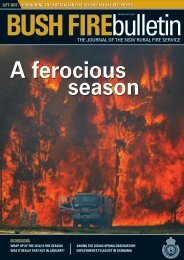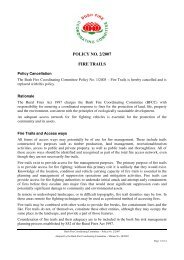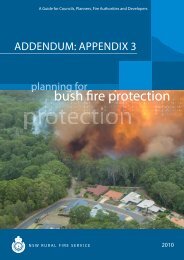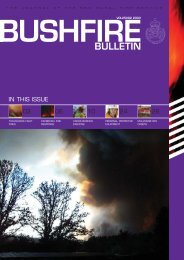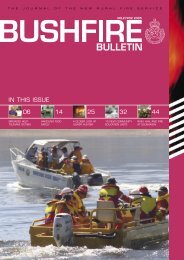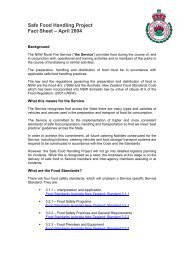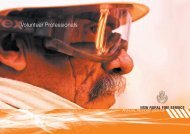GUIDELINE - NSW Rural Fire Service
GUIDELINE - NSW Rural Fire Service
GUIDELINE - NSW Rural Fire Service
Create successful ePaper yourself
Turn your PDF publications into a flip-book with our unique Google optimized e-Paper software.
Council responsibilities with regard to custodianship are as follows: -<br />
• Council will ensure bush fire prone land map outputs are in accordance with this<br />
Guideline.<br />
• Council wishing to review the Bush <strong>Fire</strong> Prone Land Map should do so in collaboration<br />
with its respective <strong>NSW</strong> <strong>Rural</strong> <strong>Fire</strong> District/Zone/Team. Refer to Section 10 for the<br />
process involving amendments and re-certification.<br />
• Council is to have the Bush <strong>Fire</strong> Prone Land Map available for public inspection at all<br />
times in council offices as pursuant to Section 146 of EP&A Act.<br />
• The Bushfire Prone Land Map shall be reviewed by council in consultation with the<br />
<strong>Service</strong> at least once in every five (5) years from the current certification date pursuant<br />
to Section 146 of EP&A Act.<br />
5. Methodology/Criteria<br />
The methodology for the designation of bush fire prone land is determined by using<br />
basic principles of vegetation mapping.<br />
5.1 Bush <strong>Fire</strong> Prone Land Mapping<br />
Bush fire prone land mapping develops a main spatial dataset.<br />
The Bush <strong>Fire</strong> Prone Land Map is the map produced to comply with section 146 of the<br />
EP&A Act and requires the generation of a spatial dataset consisting of a bush fire<br />
vegetation and buffer dataset as one layer. The bush fire vegetation data is derived<br />
from vegetation classification defined as per 5.2.1 – Bush <strong>Fire</strong> Vegetation Categories.<br />
The bush fire vegetation buffer data is derived as per 5.2.2 – Bush <strong>Fire</strong> Vegetation<br />
Buffering.<br />
The principle criteria for bush fire prone land mapping, at first glance, seem quite<br />
simple. Divide vegetation into 3 groups as per the Planning for Bush <strong>Fire</strong> Protection<br />
document and apply appropriate buffering as per the legislation. However, there are<br />
some exceptions to these criteria, which are explained in the following methodology.<br />
5.2 Bush <strong>Fire</strong> Prone Land Map Vegetation Categories<br />
This section defines the methodology and criteria for determining the bush fire<br />
vegetation layer of the dataset.<br />
<strong>NSW</strong> <strong>Rural</strong> <strong>Fire</strong> <strong>Service</strong> Page 6 of 24<br />
Guideline for Bushfire Prone Land Mapping<br />
Version 3 – June 2006<br />
G:\Community Safety\Development Control <strong>Service</strong>s\Policies and Standards\Guidelines\Guideline for BPM Version 3<br />
(formatted).doc



